A Bamboo tenkara rod has magic inside
I went fishing today.
I think you would have loved the experience I had.
But it might be difficult to explain, because I seem to have ended up on a path I never intended to take – and it is so much better than I could have imagined. So it may be difficult for you to imagine too, though I will do my best to help you.
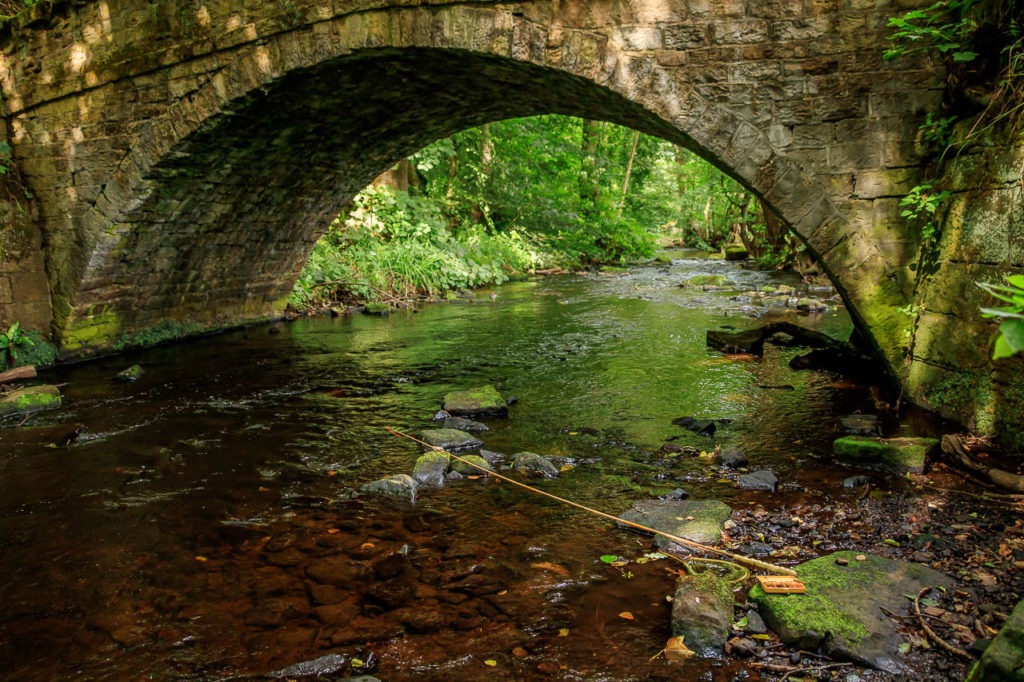
Here’s what happened – I found myself on a small, tumbling stream that is as familiar to me as the creases and hairs on the back of the hands I tie my flies with. It is cool, with dappled sunlight and shade in the midst of mature woodland. The water is whiskey-stained but clear. The trout are wild, brightly-painted and fizzing with life. It is heaven.
Today I am carrying “important things” that will allow me to fish. They are hand-made with great skill. They are as beautiful as the trout and the stream. They represent history, culture and friendships of incalculable value. I get a sense of each object having a kind of soul that their makers put into them as they were created. Because of these things, there is a peculiar thrill to carrying them as I walk towards the stream along the damp path under the trees in the cool air and pale sunshine. Here and there, dog-walkers pass through the wood on one side of the stream or the other.
They have no idea what I am doing or why I would want to.
The fly line that I am using has been perfectly twisted and neatly knotted together using long strands of a horse’s tail. Its taper has been designed over years of experience by Mr Hirata – who had to catch fish to earn money on some of the most difficult rivers in the world. It is four metres long and ends in a clear nylon tippet incorporated into it by its maker. My rod is three metres long, made of “suzutake” bamboo by Mr Saito and I have a small net that he also made out of the same material (with a rose-wood insert handle).
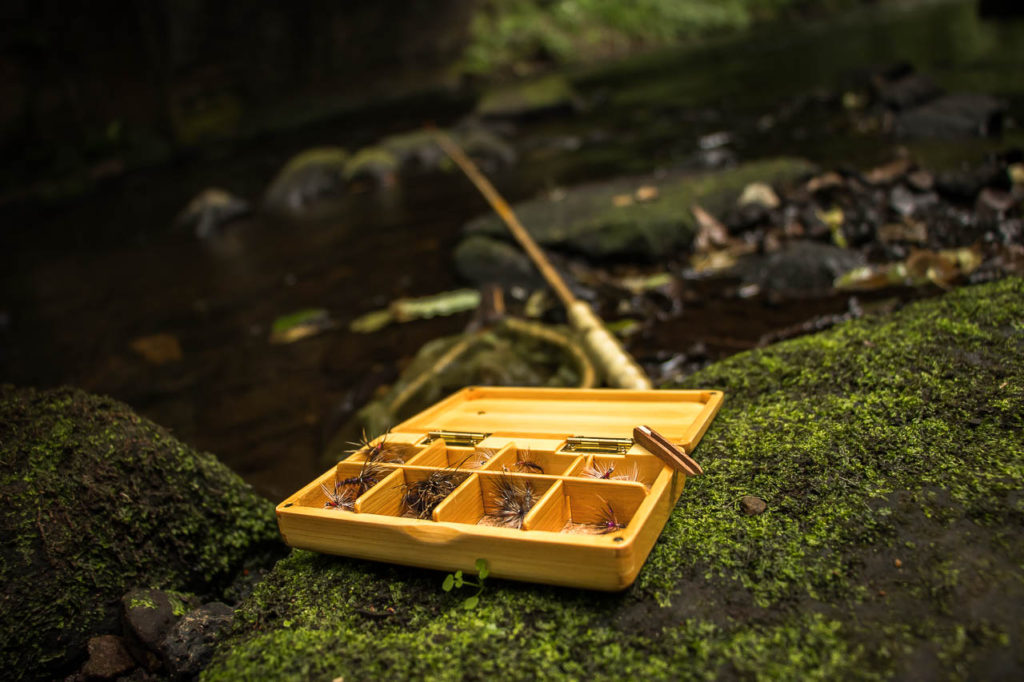
In fly fishing, you connect with a river in a way that is different from any other method. The use of materials to mimic food and the way that we have to take ourselves to where the fish are already feeding. This is quite different from bait fishing. The soft swish of the casting line that provides the impetus to deliver my near weightless fly is also completely different from the concentrated weight of a spinner or plug, cast with some speed and force. There is something graceful about fly fishing that is lovely to watch and beautiful to experience.
Now I cast that horsetail line softly and smoothly – and “paint” the simple fly onto the surface of the water – just behind a rock next to the trailing green stalks of plants handing down from a tussocky, steep bank. It travels maybe two feet downstream a few inches below the surface in the slick formed in the lee of that rock. Through the water, I can see the pale white dots of the cord used to make the eye of the fly that I’ve knotted the tippet onto. Except, now the white tell-tale dots just disappeared in a quick sub-surface swipe and I’m setting the hook before being aware that I needed to. The rod bucks, but as I try to guide its tip beneath the bridge arch at my back, some slack line develops and as I grab the casting line, I feel the pluck and then slackening which tells me the fly has popped out of the fish’s mouth.
Curses.
I check the hook point and get ready to re-cast and as I do a smile forms with the memory of where the fly came from. It had been hand-made – literally because no vice was used – by Mr Yamada in a remote mountain settlement called “Autumn-Mountain Village” or “Akiyama-go”. There are lots of stories I want to tell you about Mr. Yamada – sometime bear-hunter, sometime mountain plant and mushroom forager and lifelong professional fly fisher. I will tell many more stories soon – but if you’ve read as far as the Japanese dry fly section of my email lessons, you will know one of the patterns that was found in Akiyamago by Mr Fujioka.
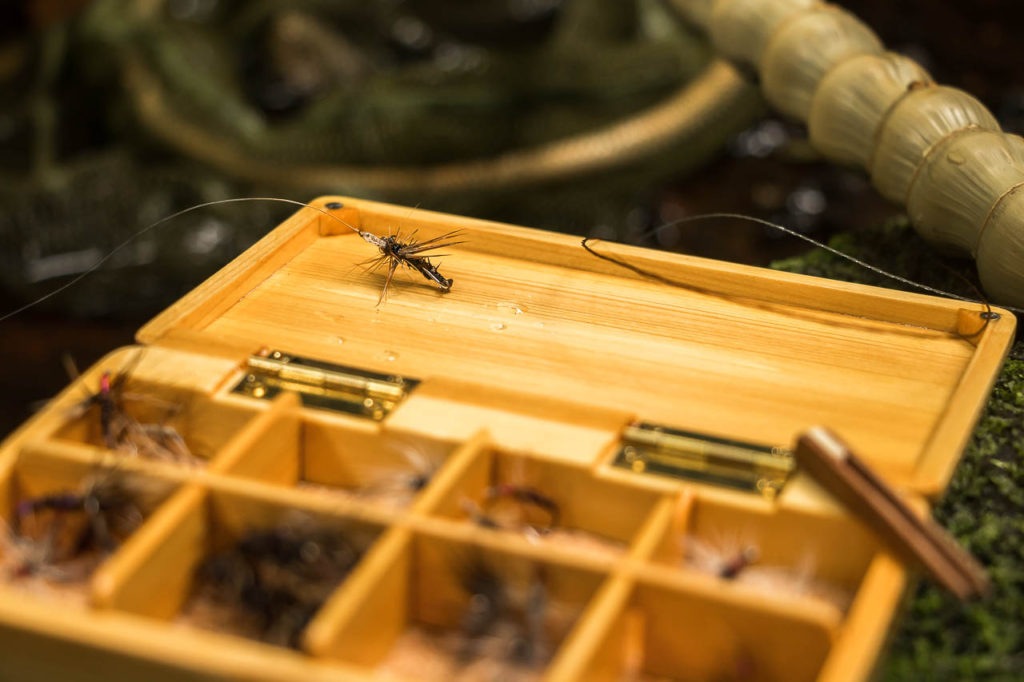
Yamada san of Akiyamago
Mr. Yamada’s tying was learned from his father and is fairly similar to the style of dressing reported by Mr. Fujioka. The main difference is that Yamada-san uses peacock herl for the body instead of a trimmed palmered hackle. Also, these days, he makes the loop-eye and short tag tail out of white braided backing line rather than furled silk. He finds that the eye stays more open because it is a little stiffer – and that makes it much easier to re-use after a fly has been removed from the tippet. I like the fly very much because it is deliberately scruffy and extremely “buggy” and also because of all the native Japanese iwana it has accounted for over a long career. It is a fly with good “juju”.
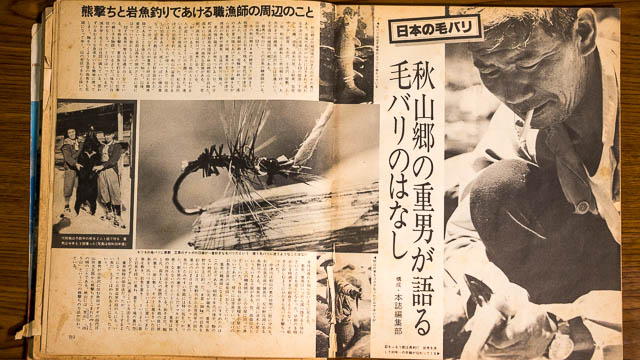
Kura-san’s Hinoki wood hand-made fly box
Today I am carrying the sleek, feather-light hinoki-wood fly box made by my friend Kazuo Kurahashi (Kura-san). It has a smooth, shiny and clear lacquer finish, brass hinges and small magnets at the corners snap it shut with a satisfying “snip”. A soft base of thin cork sheet sits underneath eight square fly compartments.
There is even a tiny pair of hand-made wooden tweezers for picking out your fly.
The tweezers have their own notch that they slide, perfectly, into in one of the wooden cross-spars that make up the fly compartments. The box is about the same dimensions as a reporter’s pocket notepad and is one of the most beautiful things I own. I’ve loaded it with a mixture of kebari (flies) tied by myself and also Mr. Saito, Mr. Sebata, John Pearson and Mr. Yamada.
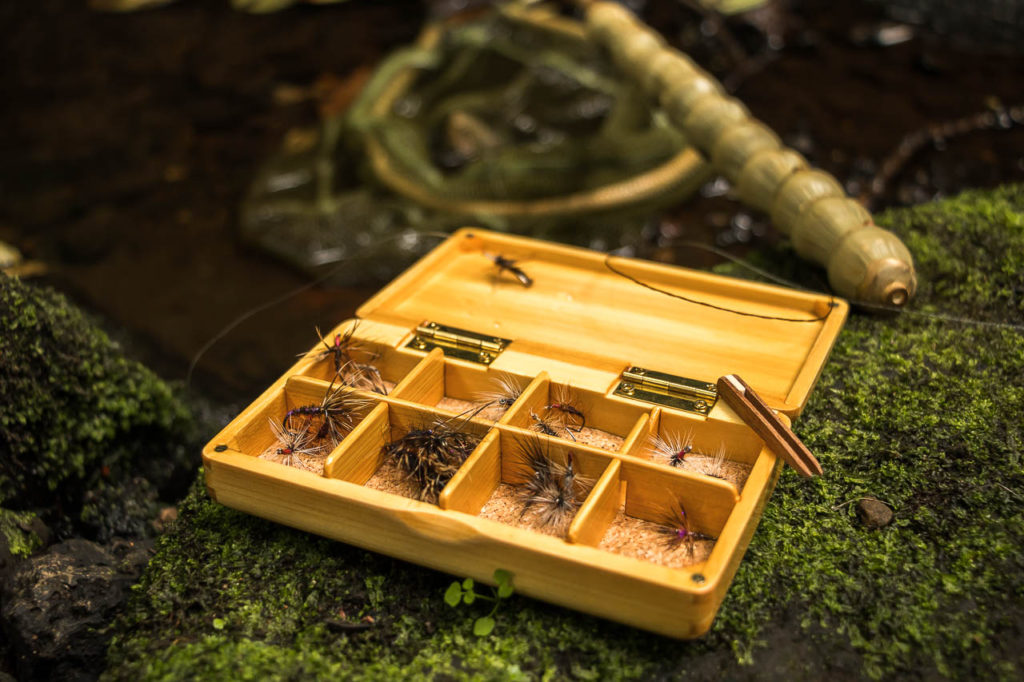
Now I re-cast, maybe two metres above the previous spot and just upstream of the first rock. The fly lands and disappears immediately in a swirl of spotted flank. This time, the fish jumps, splats and froths its way right to my feet. I am able to gather the line and unship the bamboo net from my belt and scoop up the twisting, dark metallic jewel from the stream. By placing the fish, partly submerged, in the net at the edge of the stream I am able to take some photographs. Crouching near to the water with the camera, I can smell the fusty wet earth and vegetation of the bank mingled with the cleaner, cold, damp cave-smell at the water’s surface. Releasing the fish and cycling through the pictures on the display screen, I feel a deep happiness.
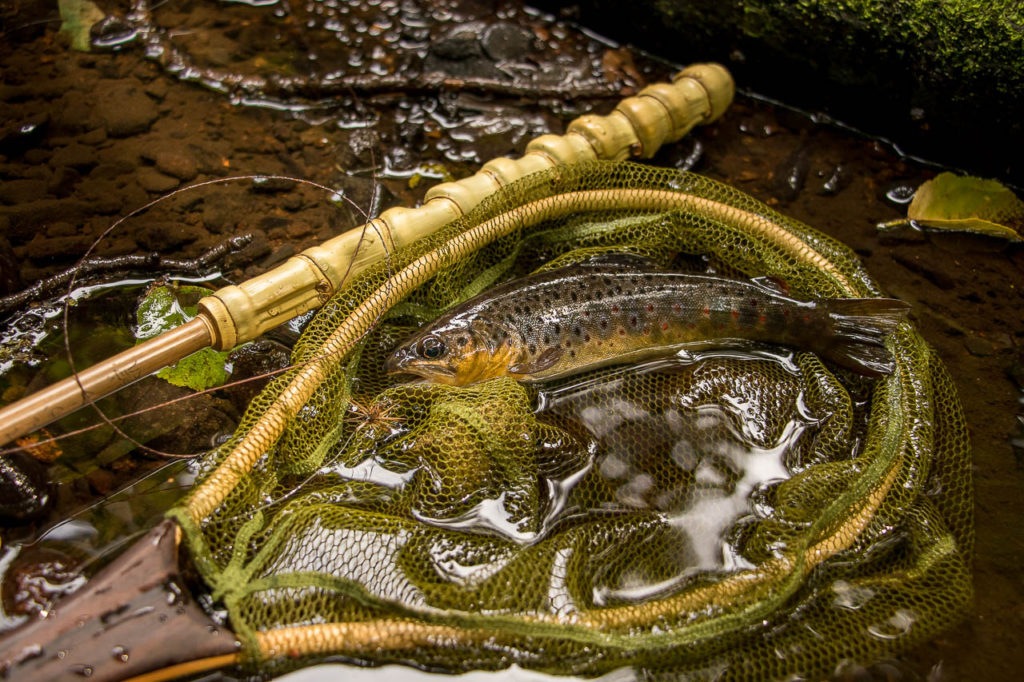
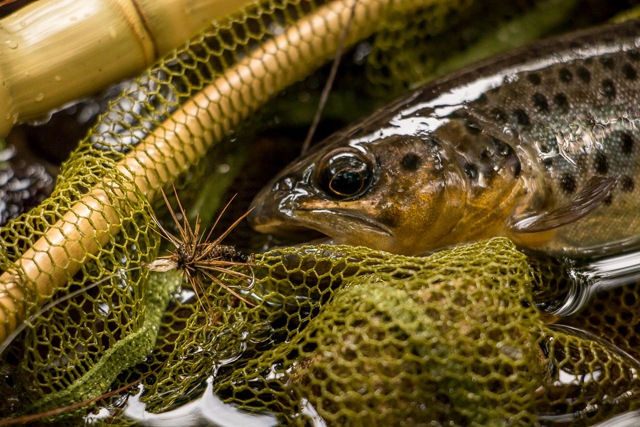
Onwards, to a flat pool and two fish snatch at the fly in flat, shallow water, but something is wrong with the drift at this cross-stream angle to the current and they don’t seem fully committed; or at least I am unable to set the hook. I exit the water and walk around, upstream, along the bank so that I can re-set and cast downstream towards the occasional dimpling rise. Four casts in, and my tapping on the rod handle during a downstream drift just animates the hackle of Mr Yamada’s kebari enough to become irresistible. A solid fish slams the fly and puts up a spirited fight which is a joy to feel through the hooped, nodding bamboo rod. A perfect shaft of light lets me photograph this fish in a natural halo, framed by the dark water and mossy rocks of this lovely stream.
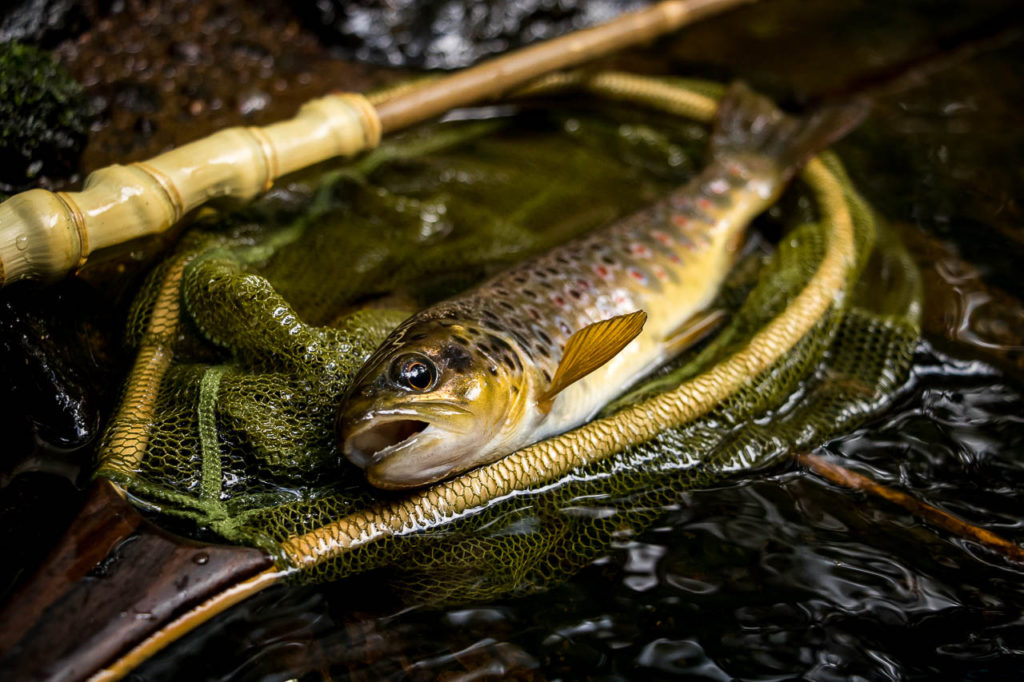
Time and Tide Wait for No-one
I could fish on forever like this, but my available hour has burned away and I must head home to my family. As I carefully unhitch the casting line and wind it back onto its keeper-spool – complete with tippet and kebari – I enjoy many pleasant thoughts and memories.
As well as the fish and the stream, I remember with pleasure the friends who had made my experience possible. All those people who had learned their crafts to make the flies in my box, the box itself – complete with tweezers, the horsetail line, bamboo rod and net. But not only those people; everyone who had taught me anything about the nature of fish and rivers – but especially the true techniques of tenkara. In many ways, I had taken all those people with me on stream. They had given me this experience and it is something I am truly grateful for.
Above all, the spirit, culture and techniques of tenkara, when brought to life in an angler’s hands, conjure not only beautiful wild fish; they produce a bottomless joy.
Knowledge and technique are the supreme elements that lead to that experience – and if you feel like your own fishing has reached a plateau I am here to tell you that there is a world of technique left for you to discover yet. You can start with my free email lessons by Clicking Here.
If you enjoyed these words and pictures, please share them with your friends by clicking your favourite “Share” button below or in the side-bar.
Paul
PS – I tried to make this trip report as close to the experience as possible – please let me know how I did/what I should have done in the comments below…

I have just eaten a leisurely Sunday morning breakfast and been transported back on stream whilst reading these words. This is probably the most evocative piece you have written Paul. I really enjoyed it. It makes me want to go to a river somewhere right now!
Thank you Glyn. Don’t fight the impulse to head out on stream hahaha 🙂
Delicious, evocative storytelling Paul, great pics too.
Cheers Neil, what kind feedback :):)
Great piece Paul, superb photography.
When you have a quiet moment on the bank its good to think of the journey taken to get where you are.
May be surprised at how much is in there!!!
You’re exactly right there Glenn. It’s actually pretty overwhelming to think back over all the experiences and the help from the kindness of a legion of folks that lead to this point.
A beautifully written piece Paul, you can’t help but to be transported to that very stream. It becomes an experience that you feel is yours.
Thankyou
Talented.
Again I can only say how kind your words are Peter and how much I appreciate them.
Well done Paul. Great writing and phptographs. I felt like I was there in person. Looking forward to my Tenkara fishing trip to the River Liffey in Kildare this afternoon.
Tight lines Tony, the Liffey sounds fantastic. Thank you for stopping by and making such kind comments.
Absolutely brilliant piece Paul.. . Great pics too. 10 out of 10.👍🎣👌😁
Wow, thank you Chris I’m delighted that you liked it. Many thanks.
For me, you are one of those people who imbue my fishing experiences with added depth and serenity. Thank you.
Alex, thank you so much- I really can’t thank you enough for your thoughts and comments. Just wonderful, thank you.
How did you do? Well, your writing style and passion for sharing your trip report where you applied traditional tenkara tools, helped me imagine how previous generations used available resources to craft tools and blend and harmonize with nature. Thank you. Always a pleasure reading your work.
Thank you so much too John, both for your comments and for taking time out of your Sunday to read my story.
Lovely piece of writing and pictures, Paul. I love the interconnected ness of finely crafted tackle and its makers, their friendships and generosity , and the sharing of their skills ….all converging into this rich, stolen hour of pure fishing. Magic!
I’m so glad you enjoyed it Alan and I’m sure that you feel a similar debt to the mutual friends we’ve met in Japan.
Thanks Paul. What a great way to start my Sunday morning. Wonderful prose and enchanting photos.
Thank you Mark, what more could I hope to achieve with an article? Many thanks.
Great piece of writing Paul. You transported me to the stream where I could sense both the elegance, simplicity, and craftsmanship and the associated pride in the rod, line, net flybox and flies. Amazing how an appreciation and delight in the tools of fishing like those can add to the experience.
Doug, it is something I’m always aware of, bubbling under the surface. If we never attached meaning and quality of experience to our activities, we would all be fishing with dynamite or poison. Thank you very much for your kind feedback.